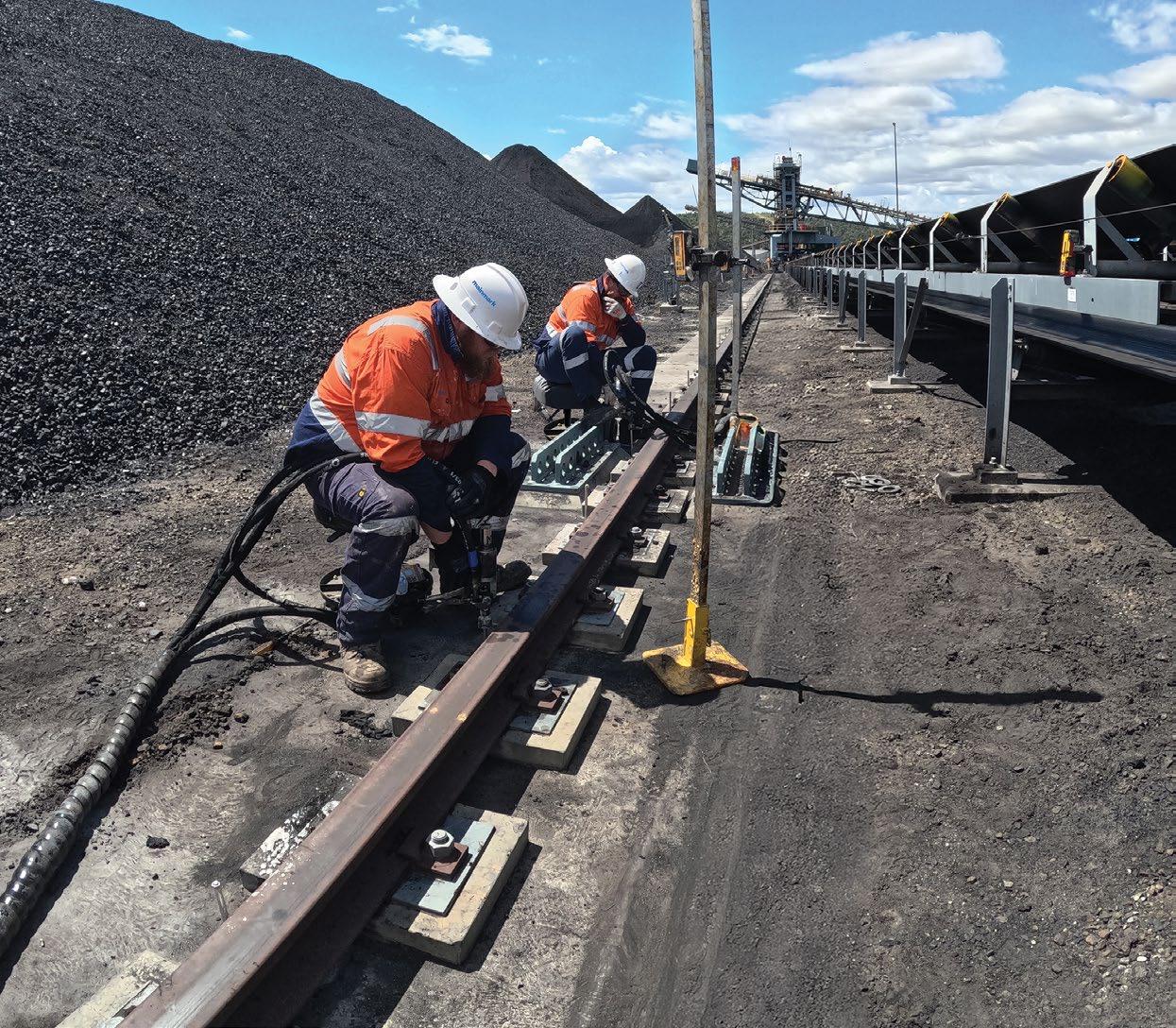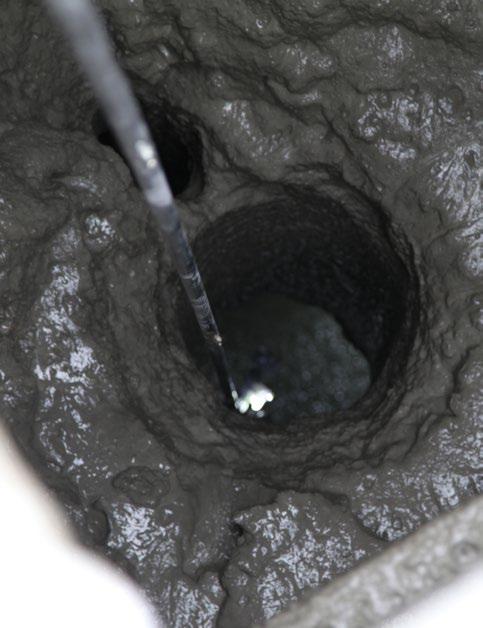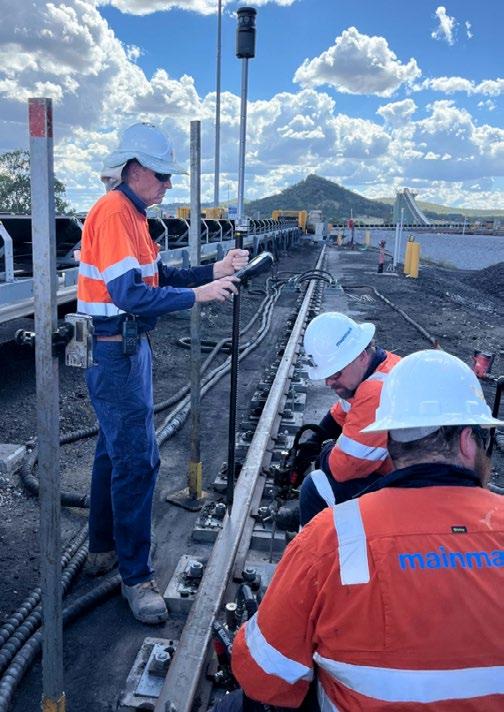





Established in 1989, Mainmark is a global ground engineering company offering innovative re-levelling, ground improvement, and void filling solutions.
Our in-house Engineers bring extensive knowledge and experience to every project.
ISO Accreditation: Guaranteeing risk mitigation and operational excellence.
Award-winning global ground engineering organisation delivering the world’s most advanced, innovative, and accurate solutions.
Mainmark has pioneered the development of Teretek®, Terefil®, and JOG Computer-Controlled Grouting Technologies in Australia.
In Australia’s dynamic mining landscape, efficiency, safety, and sustainability are paramount.

As a leading provider of innovative solutions, Mainmark is at the forefront, offering advanced technologies tailored to meet the evolving needs of the mining sector. With a deep understanding of the challenges inherent in mining operations, Mainmark delivers innovative solutions that enhance productivity and mitigate risk.
Mainmark has successfully delivered thousands of projects to mine sites for over thirty years.
We understand the importance of working collaboratively and efficiently within tight timeframes of scheduled shutdowns or emergency works, with minimal interruption to mining operations and prioritising safety.
Mainmark is committed to ensuring the Health, Safety, and Well-Being of all our Employees, Subcontractors, Customers, and Stakeholders.
Our robust integrated system has successfully met rigorous assessment against international standards, demonstrating our dedication to Work Health and Safety, with critical focus areas on:
Risk management
Training and competency
Leadership
Plant and equipment management
Management of change
Continuous improvement
Experienced Personnel
At Mainmark, we take great pride in our team of experienced personnel. Each member is a subject matter expert in delivering our specialised technologies and has completed all the regulatory requirements, including Health Monitoring and Training Competencies. This ensures that our projects are completed to the highest standards of safety, quality, and in accordance with mine site requirements.



Plant and Equipment
Mainmark has built and developed a fleet of mine-specific plant and equipment tailored for mine site compliance and prioritises safety.


We remediate and re-level mining infrastructure, processing plant, and associated equipment affected by differential settlement and subsidence resulting from soil consolidation, compaction, or long-term creep under structural loads and vibration. Our solutions restore structural integrity, alignment, and operational performance, mitigating further deformation and extending asset life.

Providing advanced in-situ ground improvement and engineered soil replacement solutions tailored to the mining industry, enhancing the bearing capacity of soils supporting mining infrastructure and equipment to address settlement, and improve foundation performance in challenging ground conditions.

Specialised void filling solutions for the mining industry, using advanced chemical and cementitious grouts to re-support foundations, backfill decommissioned underground services, and fill large voids. Our approach is tailored to the void size, location, and site-specific challenges, providing a cost-effective alternative to traditional methods while minimising operational disruptions and maintaining site productivity.

Some of the more common applications for the remediation of mine assets include:




Large Void & Mine Shaft Filling








Teretek® lifts subsided structures, strengthens ground, and fills voids.
Learn more
Terefil® is a lightweight engineered fill for soil replacement, large void filling, and pipe abandonment.
Learn more
JOG Computer-Controlled Grouting
JOG is a computer-controlled, multi-point injection system designed for precise level correction of large or complex structures.
Learn more
Low-Impact Installation – Teretek® requires only minimal access points, reducing disruption to operations and preserving structural integrity.
Since 1989, Mainmark has pioneered the Teretek® Resin Injection technology in Australia, supporting mining sites with innovative ground improvement and relevelling solutions.
Mainmark’s Teretek® technology provides efficient re-levelling and ground improvement solutions by utilising specialised expanding resins to lift and level structures without adding weight to the underlying soils. This method allows for quick and precise adjustments, enhancing bearing capacity beneath existing structures.
Rapid Deployment – Teretek® enables quick application and curing, minimising operational downtime and maintaining productivity. Learn
Precision Correction – Teretek® delivers controlled, accurate re-levelling and ground improvement beneath critical mining infrastructure.
Enhanced Structural Longevity –Strengthening ground conditions helps safeguard assets, extend infrastructure life, and reduce long-term maintenance needs.
Environmentally Safe – Teretek® is chemically inert, non-toxic, water-resistant, and does not leach harmful substances into the surrounding environment.
Re-support & Lift to Footing

Targeted Ground Improvement

Re-support & Lift to Footing
Compressive Strength
The applied density and correlated compressive strength of Teretek® materials is typically between 0.3 - 3 MPa.
Based on extensive research and experience with Teretek® and in combination with accelerated ageing tests comprising mechanical stresses, heat, moisture, temperature cycling, and chemical, mechanical and biological degradation, it was concluded that Teretek® materials under geological conditions will maintain their mechanical properties for well in excess of 50 years.
Environmental
Based on several environmental impact studies of Teretek® materials to different soil and ground water conditions, it was concluded that the Teretek® materials are environmentally inert and do not generate leachate.
Chemical Resistance
The degree of volume change during the immersion has been used to measure the material’s chemical resistance.
Chemical Resistance Rating Volume Change
Chemical resistance of the Teretek® resins according to DIN 53428 and ISO 2869.
Water / Salt Water
Methanol
Ethanol
Butanol
Acetone
Ethyl acetate
Benzene
Toluene
Chlorobenzene Monostyrene
Petrol/Benzene
Mineral Oil
Diesel Petrol
Trichloroethylene
Ammonium Hydroxide (10%)
Ammonium Hydroxide
Sodium Hydroxide (10%)
Sodium Hydroxide
Nitric Acid
Sulphuric Acid (10%)
Hydrochloric Acid (10%)
Citric Acid (10%)
Citric Acid (50%)
Bases (Alkalis)
Acids
Precision Re-levelling: JOG ensures highly accurate and fast setting grout injection beneath existing structures, delivering precise re-levelling with exceptional accuracy.
Minimally Invasive: The technology requires only small access holes, providing a low-impact, non-disruptive solution that preserves the structure's integrity.
Our JOG technology is a cutting-edge, computer-controlled, multipoint injection system designed specifically for large and complex structures.
This advanced technology uses cementitious grouts with controlled settime properties to re-level and re-support a wide range of assets, from large buildings to extensive mining infrastructure and large-scale processing plants.
The JOG system operates through a sophisticated network of interconnected injection ports, all managed and sequenced by a central computer, enabling precise injection across vast, intricate structures. This ensures consistent and accurate leveling, even in the most challenging environments.
Mainmark delivers this innovative solution with custom-built mixing and pumping equipment, which is often segmented to facilitate easy transport and access in remote or hard-to-reach locations. This flexibility ensures our technology can be deployed effectively regardless of the site’s complexity or conditions.
Quick and Efficient: JOG offers a fast, effective re-levelling solution, reducing downtime and minimising operational disruption. The gentle, incremental lift carefully restores the structure to its original level without causing stress or damage.
Computer-Controlled: The system utilises interconnected injection ports, all managed and sequenced by a central computer, ensuring seamless and precise control throughout the process.


The re-levelling process is managed by Computer Control Units (CCUs) that are programmed with an "injection sequence" tailored to the specific structure. These sequences account for the structure’s contour, position, structural capacity, and the required amount and rate of lift required. This ensures the process is gentle, uniform, and incremental, gradually "floating" the structure back to level, millimetre by millimetre.

Continuous, precise monitoring is essential for every re-levelling project. Mainmark uses a range of systems, from traditional surveying to automated robotic stations and 3D virtual models, to track the building’s response. This data is fed back to the CCU, where it is processed to adjust the injection sequence as needed, completing the JOG process.



2
The equipment is designed to be compact, selfcontained, and highly mobile to meet varying project needs. Automated containerized units can be easily segmented for access in challenging sites. The production plant and materials can be set up in as little as 40m², making it adaptable for remote locations, including international projects.
3
Small, precise injectors (25 to 40mm in diameter) are strategically placed across the target structure. These injectors can be installed up to 10 meters or more, ensuring accuracy in injection points. Androids actuate each injector based on the CCU's sequence, individually or grouped remotely, to ensure seamless control over the injection process.

JOG material formation reflects the laminar injection and lifting sequence, ensuring consistent and controlled re-levelling of the structure. 4


Exceptional Pumpability: Highly flowable material that can be pumped over distances of up to 1,000 meters, enables access to challenging or remote locations.
Customisable Density: Adjustable density ranging from 500 to 1,200 kg/m³ to meet specific project requirements and performance criteria.
Our Terefil technology provides an advanced lightweight cellular concrete (LCC) for soil replacement, large void filling and pipe abandonment.
With a significantly lower density, ranging from 500 to 1200 kg/m³, compared to the typical 2400 kg/m³ of conventional concrete and a designable compressive strength between 0.5 and 5 MPa, Terefil can be optimised for applications requiring a lightweight, highly flowable material. This balance of reduced density and adequate compressive strength makes it ideally suited for structural engineered fills, void filling, and ground improvement where minimising load is critical.
Learn more
Engineered Compressive Strength:
Reliable compressive strength from 0.5 to 5 MPa, with strength parameters adaptable according to the selected density and application.
Rapid Placement: High installation rates of up to 50 m³ per hour, providing efficient placement and minimising project timelines.

Table 3 – Terefil® LCC Typical
Specification Range:
1. Cast Density at the time of placing Terefil® LCC.
2. Compressive strength at 28-days after placing the Terefil® LCC.
3. Data in graph based on historic Mainmark testing records. Notes on Figure 2:
Terefil® LCC is specified by a minimum 28-day compressive strength and a cast density.
Cement-base, durable, stable, and environmentally inert once set.
High fluidity makes it easily gravity-placed or pumped for rapid installation over long distances.
Negligible bleed, separation, and shrinkage.
Lightweight, although if required LCC can be designed to displace water on a case-by-case basis.
Flowable and fills underground voids without vibration, with positive displacements of air towards the outlet. Excellent thermal insulator.
The Terefil® LCC is produced by mixing the base grout and foam inline or mechanically to form the specified design mix and design density product. Mainmark produces LCC using a self-contained Terefil® mixing and pumping rig. In remote or difficult access conditions, the equipment may be segmented to allow flexibility of access and ease of transport.
Terefil® LCC Production
Terefil® LCC is produced on site using a base grout with a foam mixture.
Base Grout - The base grout typically consists of cement, sand, and water, and is produced to a Mainmark mix design.
Foam Mixture - Foam is produced on site by Mainmark using the foaming surfactant and water in a foam generation unit to produce a stable foam mixture.


Problem
The ROM reclaim tunnel and much of the coal infrastructure was built on historic deep mine fill, which had been undergoing long-term consolidation. The site featured approximately 3 meters of engineered fill on top of 30 meters of loose and voided ground fill.
This consolidation had caused global settlement of surface and underground infrastructure. While the global settlement is manageable, differential settlement between connected elements has exceeded tolerable limits and required correction. Without intervention, this settlement could or lead to misalignment and damage to the infrastructure.
Solution
Mainmark worked alongside site designers to integrate its JOG computer-controlled grouting technology for future correction of critical infrastructure. Injection tubes were embedded within the site’s concrete footings, allowing for level correction.
Once the infrastructure required adjustment, Mainmark injected the JOG system through 39 ports, correcting the differential settlement.
Result
The JOG computer-controlled injection technology successfully re-levelled the ROM reclaim tunnel by an average of 225mm. The entire process was completed efficiently over two weeks, restoring the infrastructure's functionality and stability.


Problem
Located in a regional New South Wales town and beneath a carpark within metres of an operating business and a main highway, a 300m deep disused mine shaft slowly deteriorated, resulting in localised surface voiding and subsidence. Prior to Mainmark’s involvement, initial attempts were made to stabilise the shaft, and a steel collar and large concrete cap were installed. Ongoing subsidence resulted in the development of a significant void underneath the concrete cap. This void required urgent remediation so the main shaft remediation project could begin. Mainmark was appointed to complete an emergency void fill using its proprietary Terefil® solution, an advanced engineered light-weight fill material for geotechnical applications.
Solution
The primary objective was to fill the significant void and re-support the concrete cap, allowing heavy equipment to be mobilised for the main shaft remediation project. The client was seeking a cost-effective fill material that would be structurally adequate to support the proposed loads and lightweight to reduce the risk of further shaft subsidence due to imposed loads. As a highly flowable and lightweight material, Terefil® was ideal for this application. The formulation does not require pre-loading or compaction for settlement mitigation. It will flow into spaces to fill voids and exhibits shrinkage of less than 0.1%.
Terefil® contains a uniformly distributed matrix of air bubbles generated by mixing cement slurry with stable preformed foam. Cementitious materials encapsulate the air bubbles and then dissipate leaving a void structure as a replacement to traditional aggregate. Compared to typical foam fills, the patented technology used in Terefil® has increased stability, a greater lift thickness and can be pumped greater distances. Extensive compressibility testing has validated the ability of Terefil® to resist bubble collapse from pressure.
Result
Mainmark mobilised to the remote site within three days of being awarded the project. It placed approximately 540 m3 of Terefil® within three days, continuously validating results via a camera survey of the void.


Problem
The stacker/reclaimer's rail support footings, which service a coal stockpile, were experiencing general subsidence, with a notable differential settlement between the two rails. This imbalance was nearing operational tolerance limits and required correction.
Additionally, water from a fire hydrant network, hot weather sprayers, historic pipe failures, and localised surface flooding exacerbate subsidence, further compromising rail stability.
Solution
Mainmark addressed the most subsided areas of the rail support footings by drilling through the lowest sections and injecting material into the target support soils. This approach filled voids, provided additional support, and levelled the footings to within target tolerances.
The work was carefully timed to coincide with an operational shutdown to avoid disrupting the conveyor and stacker/reclaimer operations.
Result
The injection process successfully filled voids, re-supported and level corrected the rail support footings to the desired level tolerances, restoring safe operational conditions. Due to strategic scheduling during an operational shutdown, the project was completed with minimal disruption.


Problem
The floor slab of the Mine's Store and Workshop area, which supports heavy mining equipment, forklifts, and highlevel storage racks, is built on approximately 3 meters of engineered fill over 30 meters of loose, voided ground fill. Due to ongoing long-term consolidation, the slab had subsided unevenly.
Differential settlement disrupted forklift operations, high-rack stability, and the workshop’s wash bays, impacting the facility's functional requirements and level tolerances.
Solution
Mainmark used its Teretek® resin injection to fill voids, re-support the slab, and adjust it to meet operational-level tolerances. This process focused on targeted areas to minimise interference, allowing daily operations in the workshop and store to continue without disruption. Work was scheduled on days with lighter operational demand, ensuring continuous function.
Result
The Teretek® injection successfully filled voids and corrected the slab levels within target tolerances, restoring operational functionality to support equipment and racking.
This solution allowed for effective level correction with minimal impact on day-to-day operations.



As a global ground engineering and asset preservation company, we draw on over three decades of experience and knowledge in leading, developing and delivering the most advanced and accurate ground improvement, re-levelling and void-filling solutions across residential, commercial, infrastructure and mining sectors.
With an extensive portfolio of completed projects across Australia, New Zealand, Japan, and the United Kingdom we have achieved a global reputation for delivering innovative solutions to some of the most iconic projects worldwide, earning us international recognition as an award-winning ground engineering organisation.


